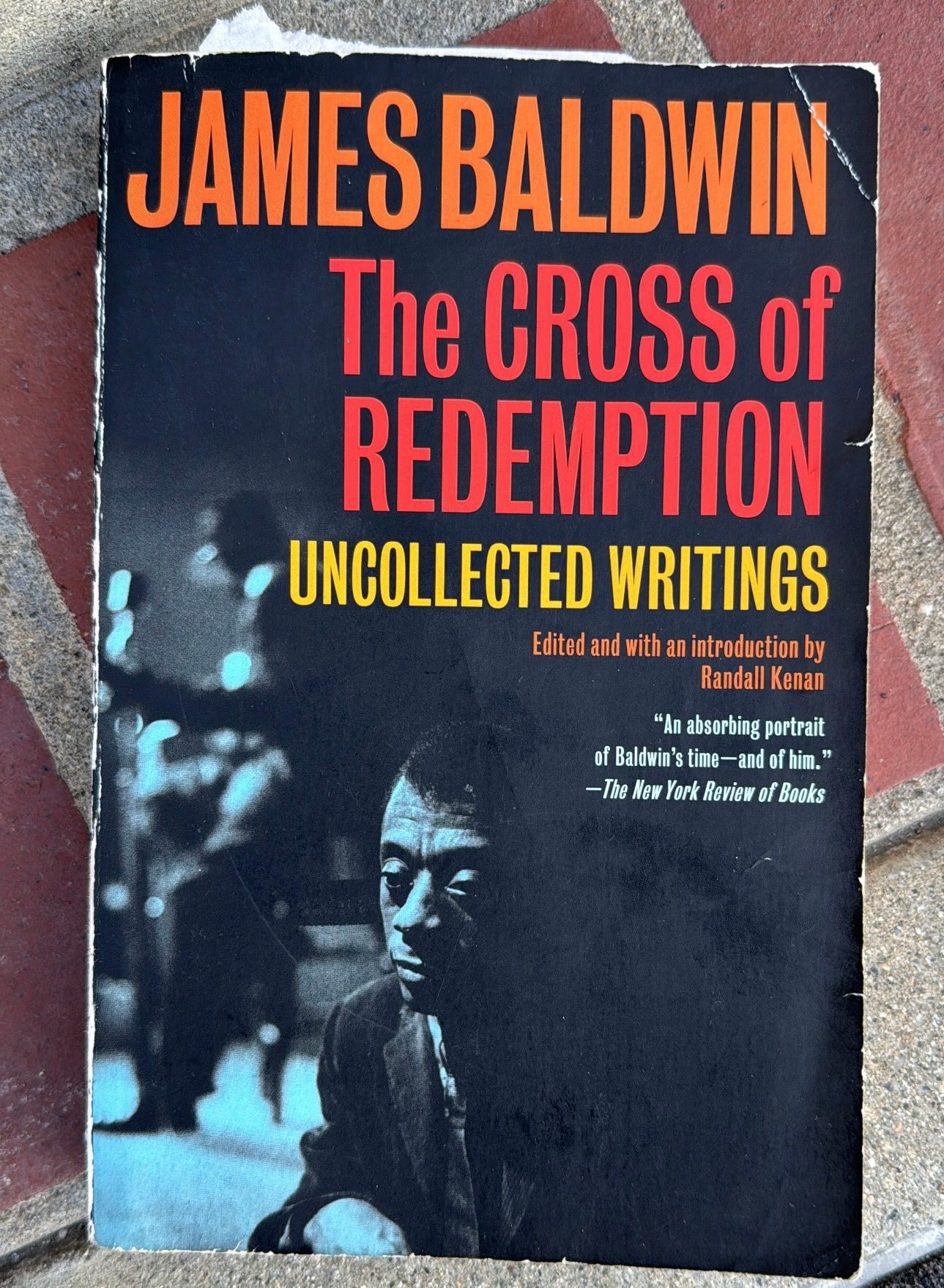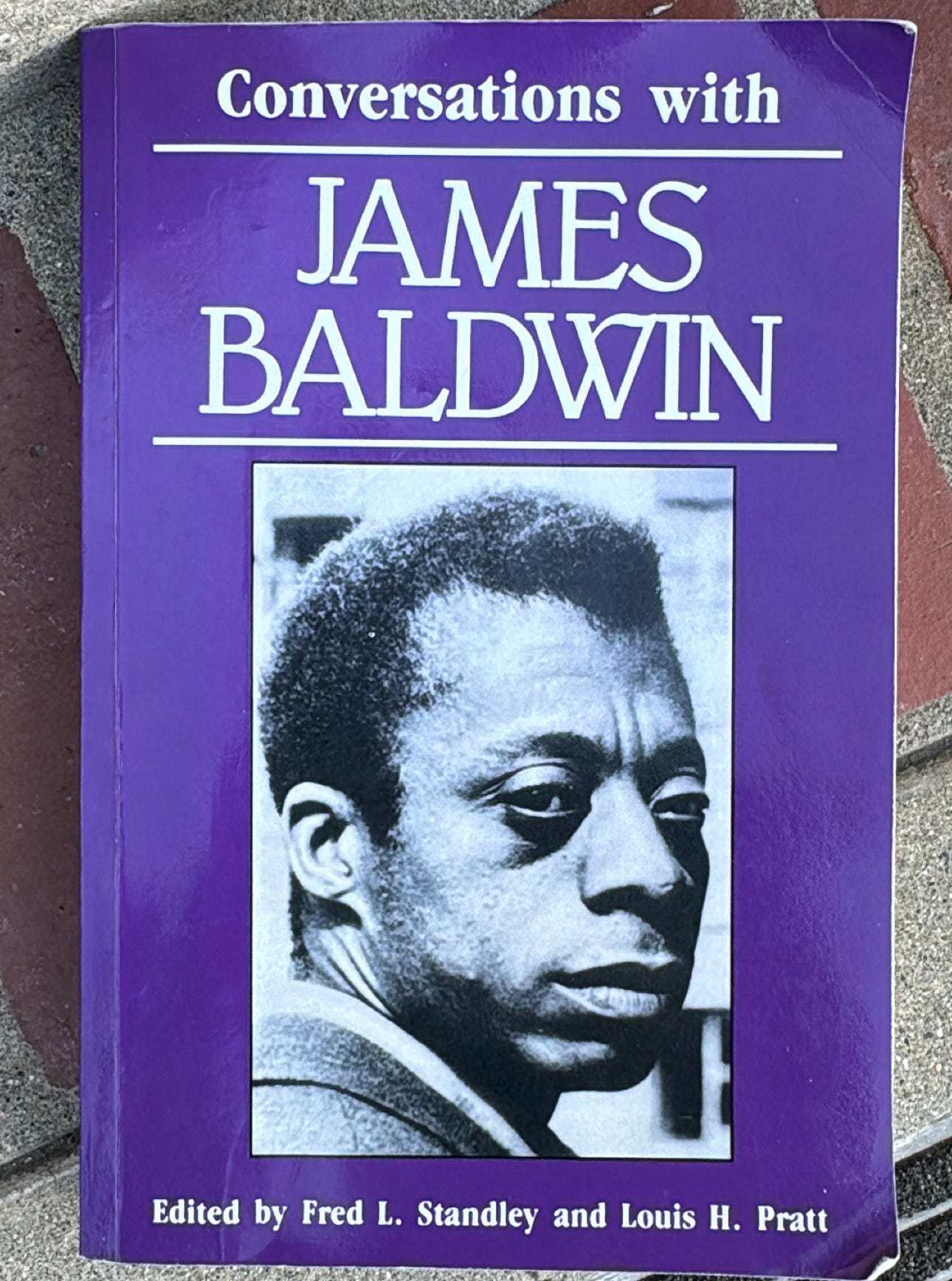Celebrating James Baldwin's 100th Birthday, Pt. 3
Through book notes, annotations and music that inspired his work: The Artist's Duty, Cross and Redemptions
“What artists and prisoners have in common is that both know what it means to be free.”
While I have previously discussed James Baldwin’s most notable works, The Fire Next Time, Go Tell it on the Mountain and Giovanni’s Room and others, this week I want to dive into other ways Jimmy left his mark on the world and in the minds of the people.
I often say that I am a better writer than I am a talker or I am better at articulating myself via the page than in front of a crowd. Of course with the space, time and revision that happens with a polished piece of writing, one is able to arrive at something more articulate or coherent. However, I'm not sure this was the case with Jimmy. There is no doubt technical precision on the page for Baldwin, but he was as eloquent on the page as he was off—during conversations, interviews, debates etc. I will touch on some of his most notable talks, debates, interviews and documentaries in the coming weeks, but for now, I wanted to talk a bit about a few of the conversations that have been collected and captured in Conversations with Baldwin, James Baldwin: The Last Interview and James Baldwin: The Cross of Redemption - Uncollected Writings.
The Cross of Redemption: Uncollected Writings - 2010
The Cross of Redemption is a collection of essays, interviews, speeches, book reviews, profiles, letters and more edited by Randall Kenan. The work spans Jimmy’s life from as early as 1947 to as late as 1987 and touches on a range of topics from the idea of an African American President to Black Nationalism to the Blues and even Boxing; however, in true Jimmy fashion, he knew to always speak truth-to-power and chronicle the struggles and triumphs of the culture, of the people, the everyday people.
This is evident when he makes seemingly ironic comparisons such as this one noted in his 1982 “A Letter to Prisoners,” in which he says, “what artists and prisoners have in common is that both know what it means to be free.” He goes on to say,
Put it another way: the warden of the prison is not expected, still less required, to answer to his conscience; he is expected (and required) to execute the will of the State. (How he explains this to his children is, cunningly enough, no concern of the State, which has every reason to believe that the son will grow up to be like the father.) Or, to put it in yet another way, the artist, insofar as the State is compelled to consider this inconvenient creature at all, is nothing more-and also nothing less-than a potential prisoner. The artist is the prisoner at large who has so far escaped his just deserts by means of his private cunning and the liberal bleeding-heart public cowardice.
This type of analysis, one that is rooted in the human condition and the desire to empathize and understand the struggles of the people is a staple of Jimmy’s practice. To paraphrase what he said in both published work and in speeches, we are only as useful as our ability to empathize and to chronicle the times. In fact, Jimmy was in the same school of an older Langston Hughes who was careful to know his work as being a “social poet,” one concerned with the plight of the people as opposed to that of a poet merely concerned with aesthetics and art for art’s sake. We know this to be true as Jimmy says,
Art, to be sure, has its roots in the lives of human beings: the weakness, the strength, the absurdity. I doubt that it is limited to our comrades; since we have discovered that art does not belong to what was once the aristocracy, it does not therefore follow that it has become the exclusive property of the common man-which abstraction, by the way, I have yet to meet. Rather, since it is involved with all of us, it belongs to all of us, and this includes our foes, who are as desperate and as vicious and as blind as we are and who can only be as evil as we are ourselves.
Included in this collection is also Baldwin’s thoughts on the artist in practice with the foreground of mass media and popular culture and the threat this poses for the integrity/aims of the artist. However, the piece I return to most often is his 1971 Open Letter to activist Dr. Angela Davis. She had been captured, imprisoned and trialed in the 1970s for her Civil Rights work and as Jimmy understood his role as a true historian and documentarian, he wrote an open letter which was originally published in The New York Review of Books. The letter, which is endearing and honest, ends with a quote that I think demonstrates the urgency of empathy: “for it they take you in the morning they will be coming for us that night.” If they take you in the morning, they will be coming for us that night.
Oppressed people everywhere are directly tied to each other through struggle and the liberation of oppressed peoples here is directly tied to the liberation of oppressed peoples everywhere. Jimmy knew this. You must too.
Conversations with James Baldwin - 1989
Conversations with Baldwin published in 1989 is a literary chronology of literary conversations with James Baldwin throughout his life edited by Fred Standley and Louis Pratt. These are the times Baldwin is rawest. Still elegant but not as technical as he is on the page. The page allowed him the skill of revision, of plugging in one word over another. In what is included in this collection, Jimmy had to use his wit and intelligence and allow it to drive the responses. They had to be from the gut or in his case, from the eyes.
My son’s eyes remind me of Jimmys, they are wide and round and the only eyes of my children not inherited from my mother. Jimmy had giant eyes that spoke before he did, like my son, Oakland. In Jimmy's case they gave the other person a part of the conversation something to listen to before Jimmy spoke, something to read—that often took a couple beats. He would lead with “well—” and let it hang for a bit before tapping his cigarette on the ashtray an delivering his sermon in true Pentecostal style. Undeniably presentable.
In response to a 1967 interview with Cep Dergisi in which Degersi asks if Black folks are in danger of losing their “rich spiritual heritage” in quest of material equality, Baldwin responds, “A man with no future is a man without a heritage. We will worry about preserving our heritage when we have set our children free.” Jimmy, in a later interview would say that we have a single responsibility and that is to our children.
And of course, he would double down in his assertion of being a social poet or a poet concerned with the people in his 1980 Conversation with Leonard Ray Teel,
The poet is created by the people. He is created by the people because the people need him. And the people may often dislike him, the poet they have created. They may even put him in jail. They may even stone him to death. But they created him because they needed him.
James Baldwin: The Last Interview and Other Conversations - 2014
One of my favorite collected conversations of Baldwin is The Last Conversation and Other Conversations which includes transcripts of Jimmy and Julius Lester, Richard Goldstein and Quincy Troupe. In these conversations, Jimmy discusses sexuality, race, politics, music, media, and writing while abroad. In these conversations Jimmy dropped nuggets such as:
“One cannot escape anything one has done. One has got to pay for it. You either pay for it willingly or pay for it unwillingly.”
and
“The discovery of one’s sexual preference doesnt have to be a trauma. It’s a trauma because its such a traumatized society”
and notably,
“You don't realize you’re intelligent until it gets you in trouble.”
My favorite conversation of the four is with Studs Terkel which begins with “Backwater Blues” by Bessie Smith playing as the lyrics are transcripted. It is in this interview that Jimmy’s language outlines how I have come to understand my origins with my own writing career. I believe I am a writer because of a few folks: my oldest sister Tenesha Smith who is also a poet and who left behind an album of poems she had written while in high school for me when she moved away; my 9th grade English teacher who bought me The White Boy Shuffle by Paul Beatty; my grandfather who was a carpenter and made magic with his hands, the same way poets do; and lastly, Jimmy, who says,
I suppose finally the most important thing was that I am a writer. That sounds grandiloquent, but the truth is that I don't think that, seriously speaking, anybody in his right mind would want to be a writer. But you do discover that you are a writer and then you haven't got any choice. You live that life or you won't live any…If you don't live the only life you have, you won't live some other life, you won't live any life at all. That's the only advice you can give anybody. And it's not advice, it's an observation.
I hope these notes will be an inspiration to young writers in that it illustrates that being a writer is less of a hobby or a vocation or career even, but rather a way of looking at the world and recognizing the plight and the flight. The music and the still. The lies and the fires, the beautiful and the triumphant and saying
I should write this down and get it right.
This week's song is “Ne Quiette Pas” by Nina Simone, which Jimmy listened to on repeat on vinyl.






